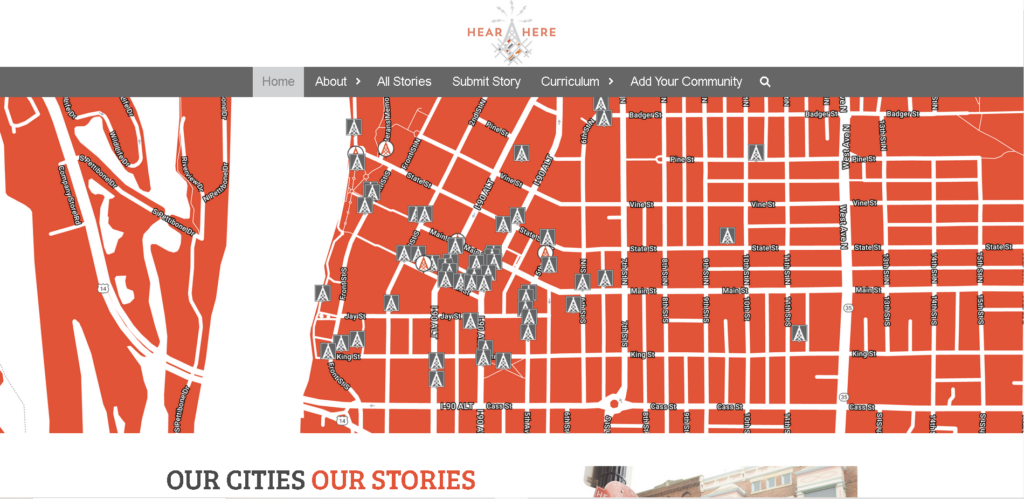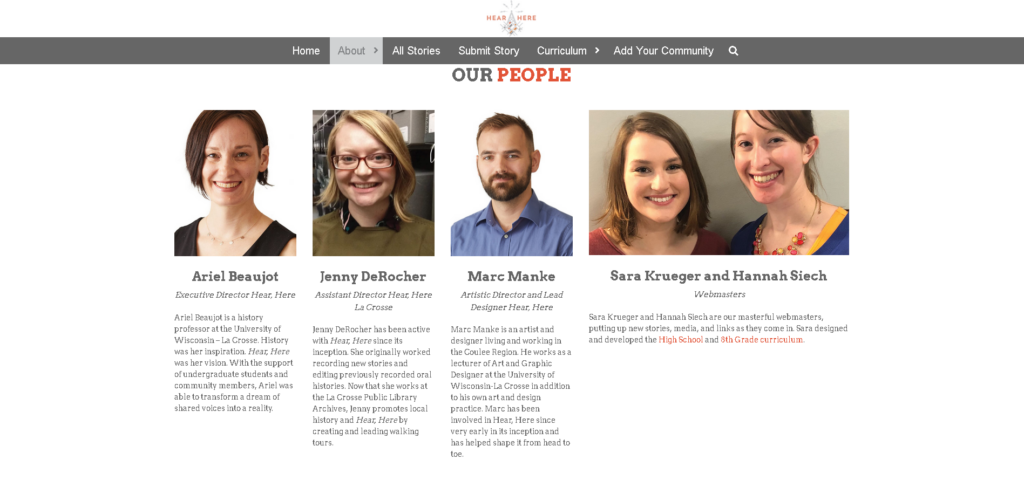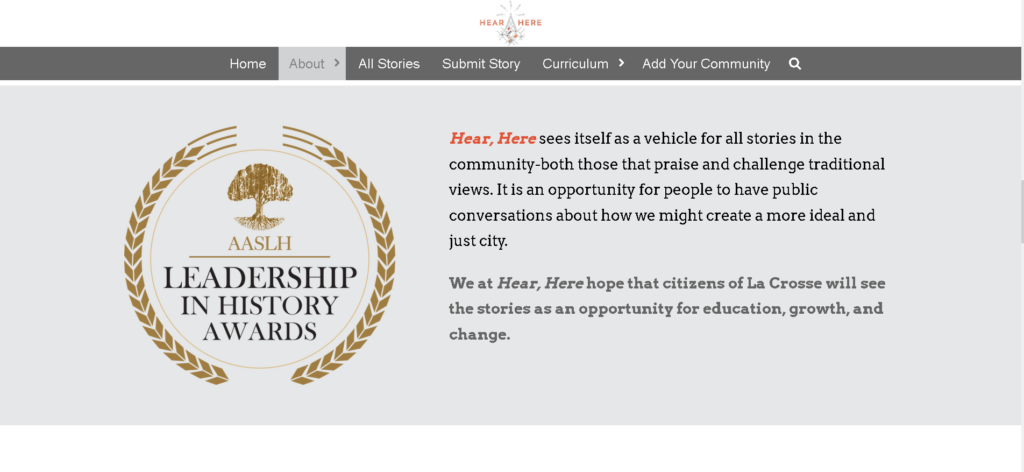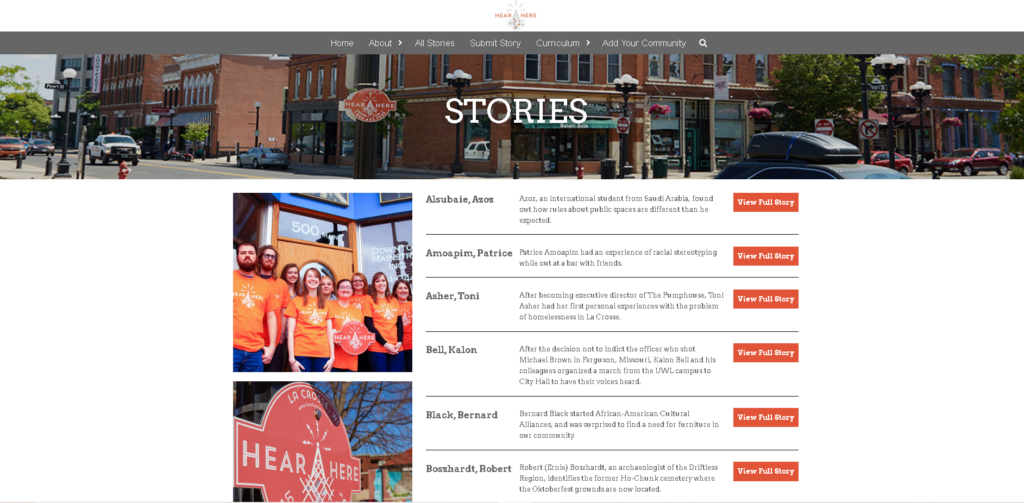Hear Here.https://www.hearherelacrosse.org/.Created and maintained by Ariel Beaujot, Jenny DeRocher, Marc Manke, Sara Krueger, and Hannah Siech.https://www.hearherelacrosse.org/about/. Reviewed Sep. 27, 2023-Sep. 28, 2023.

Hear, Here seeks to catalogue the stories of downtown La Crosse, WI
There is almost nothing that would distinguish the city of La Crosse, Wisconsin from any of the other moderately sized population centers that are scattered along the banks of the Mississippi River. Yes, it is a college town, home to the University of Wisconsin-La Crosse; but again, there is little that marks La Crosse as ultra distinct from any other of the dozens of towns of its kind all across the country.

Yet it is perhaps because of this very sense of “typicalness” that makes the endeavors of Hear, Here La Crosse not only captivating, but incredibly vital from an academic and a non-academic perspective. This review will focus on the merits of Hear, Here as an academic historical database, while also acknowledging the significance of the project as being a kind digital monument to the town itself and-more importantly-to those that inhabit it.
While Hear, Here has gone well beyond the realm of academia, it did ultimately get its start among the classrooms, students, and faculty at UWL. It began as the vision of one person: Ariel Beaujot, a professor of history at UWL, and as a part of the Public Policy History Major and Photography Minor at UWL in the 2014-2015 school year. Although initially limited to just that, the project soon began to pick up steam and more people became involved; such as such as Jenny DeRocher, assistant director of Hear Here who now also works as an archivist at the La Crosse Public Library Archives, Marc Manke, a lecturer of Art and Graphic Designer at UWL who serves as the projects artistic director and lead graphic designer, and Sarah Kruegar and Hannah Siech, who serve as the sites webmasters and have since written both the high school and 8th grade curriculums for La Crosse schools. Beaujout, who is the executive director, also included multiple members of UWL history and photography students from the 2014-2019 classes, as well as academic interns and community volunteers. Additionally, Laura Gooden, an archivist at the Murphy Library, played an instrumental role in including and guiding students in the project and mentioning Hear, Here to local research circles; while Calli Niemi, the phone system designer, worked to develop the unique calling system of Hear, Here that allows passerby to access the accounts of the archive on the go.


Hear, Here is a project that, by its very nature, seeks to provide a platform for people to share stories and experiences that relate to the downtown La Crosse area. From the very beginning however, special emphasis was placed on providing a space for traditionally non-represented or ignored groups. In the words of Hear, Here themselves: “Citizens of La Crosse hear about the big history of the city. We know about our founder…lumber barons…about the 89.8% white population. We do not hear about the 10.2% made up of…other ethnic groups. Groups like the LGBTQ+, foreign nationals, and those who have experienced homelessness have often been overlooked in our history.” Hear, Here essentially seeks to provide a platform for stories like this to be documented and told in their own community, while making sure this platform is as accessible as possible. In this regard, Hear, Here has greatly succeeded. Since its conception in 2014-2015, the project has collected around 69 stories told by people from all walks of life in La Crosse. With the addition of each new story, Hear, Here also affects an orange sign on the exact location where the events of that account happened. Those who come across one of these signs can dial the number and hear the first person account of what occurred at that location. Additionally, one can access a story through the map provided at the homepage of the Hear, Here website. The project has been ongoing since 2015, and has since received sponsorship from both the UWL Department of History and the UWL College of Liberal Arts as a whole, as well as several notable local organizations such as the La Crosse Community foundation and the Wisconsin Humanities Council.

As a historical database, Hear, Here is a wonderful example of a digital archive that provides a space for a unique and traditionally overlooked avenue of historical data, it also is highly communicative in said historical data and makes it very accessible and easy to navigate. Entire pages dedicated to the displaying and sharing of information-both about the archive and its data-are easy to find from the site’s homepage. Any and all information regarding the nature of Hear, Here, its goals, history, and its contributors can easily be found on the sites ‘About Us’ page. There is also the ‘All Stories’ page, where all sixty-nine of the stories currently cataloged are kept for anyone to access.

Visitors to the site can choose any one of the accounts that interest them, up which they will gain access to the account both in audio and digitized transcript form. Perhaps the most unique thing about Hear, Hear’s website is the interplay between the digital archive and the digital map catalog on the homepage. As stated previously, whenever a new account is added to the Hear, Here archives, an orange street sign is posted at the exact location of the account’s events. Each of these signs are cataloged on a digital map (as seen above) which show the site of the account in relation to all the others as well as the greater downtown La Crosse area.
For example, those at 200 5th Ave. S may find the orange sign to be intriguing, but may not have the time to call in and listen to the recording. So instead they can access it digitally through the website by utilizing the map spread and finding the one that corresponds to that location. Doing so, they’ll be given the following account of Xong Xiong, a Hmong (pronounced Hmoob) activist who staged a sit-in protest at a congressman’s office and was subsequently charged for trespassing. Readers and listeners will learn of Xiong’s intentions behind what she did, and ultimately how the history of the Hmong people’s experience with war drove her to take such action.

Xiong’s account is just one of many that can be found in the digital archives of Hear, Here. While the project is primarily community based, being by and for the members of the community of La Crosse, the information is open to anyone willing to access it. In a time of increased vocalization of the importance of non-traditional historical methodologies like oral history, as well as the push for the inclusion of traditionally marginalized groups, Hear, Here has become something of a pioneering force of that movement in the context of a single community. The project, as well as the website, provide a platform for the accounts of Black, Hmong, Ho Chunk Native, Latinx, LGBTQ+, and homeless voices as well as those of many others. Even for those with no connection to La Crosse, Hear, Here provides an invaluable opportunity to gain insight to attitudes, experiences, and perspectives of people from all different walks of life, even if it is all within the context of one area in one town out of all of the towns in the United States. That unremarkableness of La Crosse, coupled with all the site has to offer, ultimately leaves those who visit curious about the possibility of such stories in their own community; therefore, Hear, Here: La Crosse not only provides invaluable data for a single area, but also in a very indirect way encourages visitors to continue the digital cataloging of historical data in the context of their own communities.
Leave a Reply